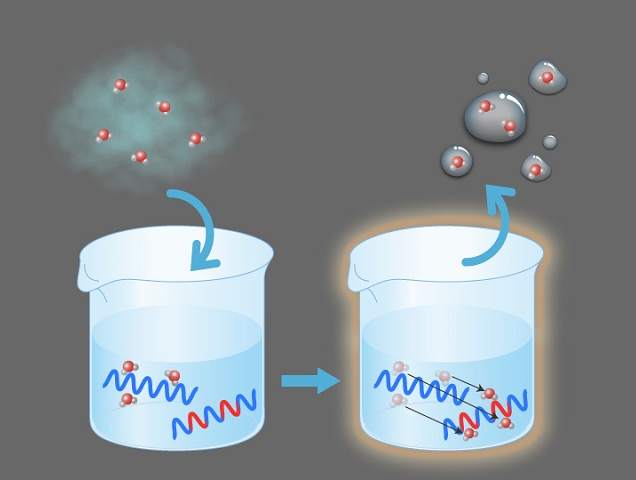Research News
Nov 27, 2024
- Engineering
Making a difference: efficient water harvesting from air possible
Copolymer solution uses water-loving differential to induce desorption at lower temperatures
Harvesting water from vapor
Water molecules in vapor are drawn to a water-loving polymer in a copolymer solution. The presence of the less hydrophilic polymer causes an exchange that helps release the water under near ambient conditions.
Credit: Osaka Metropolitan University

Harvesting water from the air and decreasing humidity are crucial to realizing a more comfortable life for humanity. Water-adsorption polymers have been playing a key part in atmospheric water harvesting and desiccant air conditioning, but desorption so that the polymers can be efficiently reused has been an issue. Now, Osaka Metropolitan University researchers have found a way to make desorption of these polymers more efficient.
Usually, heat of around 100°C is required to desorb these polymers, but Graduate School of Engineering student Daisuke Ikegawa, Assistant Professor Arisa Fukatsu, Associate Professor Kenji Okada, and Professor Masahide Takahashi developed a liquid moisture adsorbent that requires only a temperature of around 35°C to do so.
This became possible through the use of random copolymers of polyethylene glycol, which adsorbs water well, and polypropylene glycol, which adsorbs water slightly less well. The difference in their water-loving properties created a transfer mechanism that broke down the water clusters, freeing the water more easily.
“This technology has the potential to be applied not only to water supply in arid regions and places with limited energy resources, but also to ensuring access to water in times of disaster and emergency,” Dr. Fukatsu proclaimed.
“Improvements to this technology are also expected to lead to reductions in greenhouse gases and more efficient use of water resources,” Professor Takahashi added. “From now on, we will aim to improve the liquid moisture adsorbent and increase the efficiency of the entire system in order to make it practical.”
The findings are published in ACS ES&T Water.
Funding
This work was partially supported by grant-in-aid from the Ministry of Education, Culture, Sports, Science, and Technology (MEXT), administrated by the Japan Society for the Promotion of Science (JSPS) (JSPS KAKENHI Grant Numbers JP20H00401, JP22K14492, and JP24K17511), Izumi Science and Technology Foundation, Kansai Research Foundation for Technology Promotion, Nippon Sheet Glass Foundation for Materials Science and Engineering, and Toshiaki Ogasawara Memorial Foundation.
Paper information
Journal: ACS ES&T Water
Title: Liquid Polyether-Based Water Harvester for Near Ambient Temperature Operation via Hydrophilicity-Difference-Induced Water Transfer
DOI: 10.1021/acsestwater.4c00775
Authors: Daisuke Ikegawa, Arisa Fukatsu, Kenji Okada, Masahide Takahashi
Published: 29 October 2024
URL: https://doi.org/10.1021/acsestwater.4c00775
Contact
Graduate School of Engineering
Arisa Fukatsu
Email: fukatsu[at]omu.ac.jp
Masahide Takahashi
Email: masa[at]omu.ac.jp
*Please change [at] to @.
SDGs

